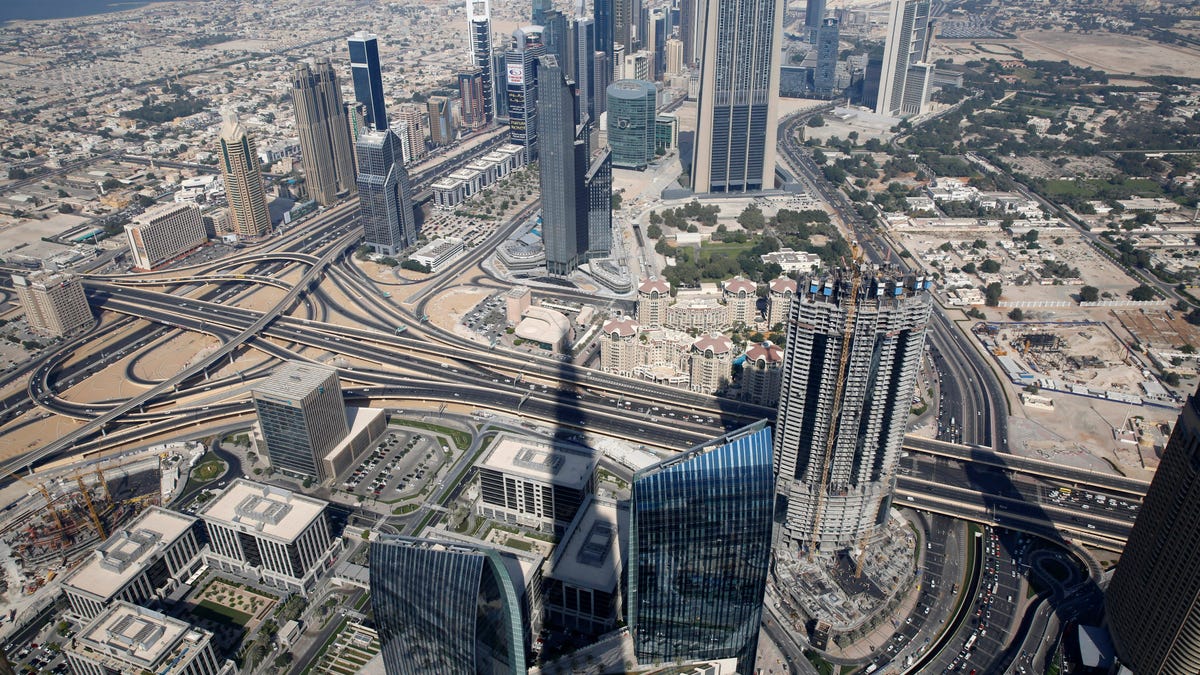
An aerial view of Dubai from Burj Khalifa, the tallest building in the world, in Dubai. (REUTERS/Ahmed Jadallah)
Temperatures in the Persian Gulf could reach levels by the end of the century that would be extreme for most people, making some of the poorest regions inhospitable and posing significant challenges to the hajj pilgrimage in Saudi Arabia.
Based on several climate models, the authors writing in Nature Climate Change Monday predict that temperatures as high as 113 degrees Fahrenheit would become the norm during the summer in the low-lying region of the Persian Gulf. Kuwait City and the city of Al Ain in the United Arab Emirates could see temperatures exceed 140 degrees Fahrenheit – so far the highest temperature ever recorded on Earth – during some years. And 2022 World Cup host Qatar, which gets hot dry air from the desert and moist air from the Gulf, could also see extreme temperatures.
“What we are talking about is significantly more severe than what people have experienced anywhere before,” Elfatih Eltahir, a co-author on the study from the Massachusetts Institute of Technology, told reporters when asked to compare it to recent waves like Chicago in 1995, Europe in 2003 and Russia in 2010, during a press conference last week.
Known for its expansive deserts and mostly clear skies, the region that includes the U.A.E., Qatar, Kuwait, Iran, Saudi Arabia and several other countries is no stranger to heat waves and record breaking temperatures. The summer months from May to September routinely go over 100 degrees, forcing all but the hardiest to spend their days in air conditioned malls and skyscrapers. This summer was among the worst yet, with Iran and Iraq experiencing scorching temperatures and the heat index – a combination of temperature and humidity – that made it feel like 164 F in one Iranian city.
Unless greenhouse gas emissions are reduced, the researchers are predicting the heat index could go as high as 165-170 F more frequently especially in the summer months of July and August and that a heat index reading of 130-140 F would become an almost daily occurence.
Related: Searing 164-degree temps in Iran as 'heat dome' traps Middle East
Places like Dubai, home to the world’s tallest skyscraper and the playground for many of the world’s rich and famous, have the resources to adapt to the hotter conditions. But the extreme conditions could be a “serious situation” in places like impoverished and war-torn Yemen, Eltahir said.
“People who have resources could use air conditioning and avoid the outdoors during heat waves but, in some corners of that region, there are communities and people who don’t have resources to do that,” he said. “We pointed to some corners of Yemen along the Red Sea that are not as well off as other parts of the Gulf Region.”
Eltahir and his co-author, Jeremy Pal of Loyola Marymount University in California, said the region’s economy would also take a hit and that the “the most basic outdoor activities are likely to be severely impacted.” Heat waves would take a toll on most work done outdoors, with everything from construction to agriculture to services related to the oil and gas industry suffering.
Sports, too, could be compromised, since football and several other outdoor sports are played at stadiums without any air conditioning. Qatar has twice failed in its bid to host the Olympics due to heat concerns and the 2022 World Cup, awarded to Qatar over bids from the United States, Australia and several other countries, came under fire over fears it could put the lives of players and spectators at risk due to the heat.
As a result, FIFA earlier this year approved moving the tournament to the cooler, winter months.
Related: Phenomenal temperatures slam Middle East, driven by extreme heat and humidity
For the millions who attend the annual hajj in Saudi Arabia, an already crowded and sometimes deadly ritual in Mecca is also likely to become even more dangerous due to the heat. Held annually based on the lunar calendar, the hajj can take place in the summer.
“These extreme conditions are of severe consequence to the Muslim rituals of hajj, when Muslim pilgrims pray outdoors from dawn to dusk near Mecca,” the authors wrote. “This necessary outdoor Muslim ritual is likely to become hazardous to human health, especially for the many elderly pilgrims when the hajj occurs during the boreal summer.”
Christopher Schar, of the Swiss-based Institute for Atmospheric and Climate Science, who contributed an article accompanying the study, said it highlights the potential dangers to humans from rising temperatures and makes sense given historical trends showing the region getting hotter in recent decades.
“The new study thus shows that the threats to human health may be much more severe than previously thought, and may occur in the current century,” he wrote. “The study also indicates that mitigation measures (reducing global greenhouse gas emissions) and adaptation efforts (protecting against heat waves) are essential for the inhabitants of the Gulf and Red Sea regions.”
